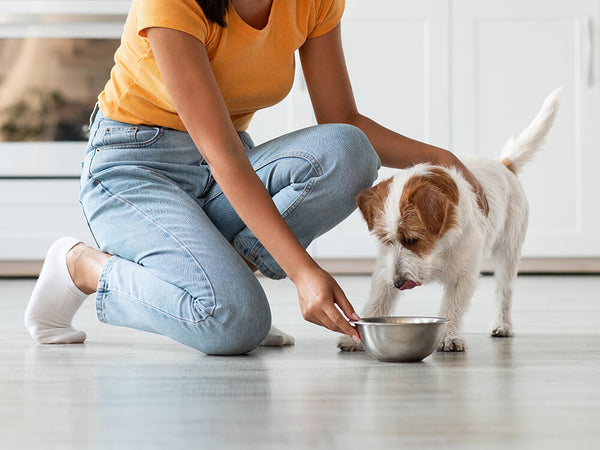How to Keep Your Dog & Cat Hydrated
Written by: Richard Rowlands
Many pet parents focus a lot of attention on their fur kid’s diet. High-quality food is essential to a long, healthy life. But so is hydration for dogs and cats.
Keeping your dog or cat hydrated is extremely important, especially during warm summer months where they may be losing more than they’re getting. And for some, that means going beyond always keeping a bowl of water available for them.
In this post, we’ll look at why hydration for dogs and cats is so important. We’ll also provide you with some practical tips to keep your pets hydrated.
Why Is Hydration Important for My Pet’s Health?
Proper hydration is vital to the health and happiness of your pet.
When our pets become dehydrated, they generally appear sluggish and fatigued. This is because the flow of oxygen to the brain is negatively impacted, and the heart has to work harder to pump blood through their body. This is hard work! Proper hydration is essential for avoiding this and maintaining energy levels.
As well, when your pet is adequately hydrated, they’re going to be able to regulate their body temperature better. This will be done through panting, which causes them to exhale and lose body moisture. A dehydrated pet is less likely to pant and will run hotter, which can be a real health risk.
Staying hydrated will safeguard against preventable health problems like urinary tract issues. Your pets’ kidneys will also thank you because chronic dehydration can lead to severe and painful issues like kidney disease, kidney stones, and even kidney failure.
There are some typical early warning signs that your pet is dehydrated. As we mentioned, these can include low energy and excessive laziness. But if you’re unsure if your furry friend is just taking it easy because of hot weather, you can also check their mouth for additional clues. Dry mouth and gums will be a sure sign that they require some hydration.
More severe signs include excessive panting, loss of appetite, and sunken eyes. Your pet may even begin vomiting or have diarrhea, which is extremely worrisome as there is even more moisture being lost from their bodies in these situations.
But don’t worry, all of this is avoidable!
How Can I Keep My Pet Hydrated?
By following some easy and practical methods, you’ll be able to ensure your pet stays properly hydrated. You should always provide plenty of fresh water and bring water with you on trips. You can also give access to running water and feed wet or water-soaked food. And in emergency situations, having an oral electrolyte solution on hand can save the day as you head to the veterinarian.
Fresh Water In The Home
Having access to fresh, clean water is the number one way to ensure hydration for dogs and cats. Water bowls should be big enough to accommodate all your pets if you have more than one, and you may also consider placing multiple bowls throughout your home. Clean these bowls daily and re-fill them at least once a day as well.
Cleaning water bowls is essential to avoid the buildup of potentially harmful bacteria and eliminate any dirt or food particles your dog might introduce by sticking their face in the dish. Sometimes you’ll notice a slick, slime-like coating forming on the bowl. This is what you want to clean off each time!
Multiple bowls are good if you have a large home or tend to spend time with your pet in various areas, especially when they’re on different levels of the house.
Bring Water with You
When you head out for a walk or take a car trip somewhere, you should always have water on hand. Even if you’re just going to grab some new treats for your pet at the store or taking them for a checkup at the vet, having that water in case they need it is essential.
Two-in-one water bottles with bowls are perfect for walks. They fill just like a water bottle, and their tops flip open to allow for easy drinking. If your pet isn’t keen on drinking from one of these, you can opt for a collapsible bowl and simply used bottled water instead. Both options are super portable and make hydration for dogs and cats easy on the go.
Running Water
Some pets, especially cats, aren’t keen on drinking from water bowls. This is because the water in the bowl can grow stagnant, and some pets are less enthusiastic about drinking water that isn’t extremely fresh.
A pet water fountain keeps the water circulating, giving fewer chances of accumulating odors or bacteria. And many have built-in filtration systems. This is great because it ensures your cat or dog is getting fresh, clean water constantly.
Hydrating Food Options
It may seem odd to talk about hydration when we discuss a pet’s food, but it’s actually a fantastic way to introduce some additional hydration into their diets.
One of the easiest ways is to soak dry kibble or cold pressed food in water before feeding. This way, when your dog has its meal, it will be consuming all the water as well. Some dehydrated foods and freeze-dried foods that must be soaked prior to feeding offer additional hydration and many nutritional benefits thanks to less processing and great ingredients.
And when soaking food, you can use bone broth or soup toppers to ensure your pets gobble up their food and stay hydrated. Bone broth can also be used independently and is great for enticing a lethargic or reluctant pet to drink something when they’re being stubborn.
High-quality canned food is another moisture-filled option when it comes to food. It can be used as a topper or mixed with soaked kibble or dehydrated food as well. Your pet is sure to want to eat this, even if they’re acting lazy.
Electrolyte Solutions for Pets
These are great to have on hand in emergency situations or to mix in with your pet’s food when you’re worried about hydration for dogs and cats. They will contain many essential and vital nutrients vital to the proper functioning of your dog or cat’s internal systems.
They should not be given regularly without consulting a vet. If you find yourself needing them regularly, consult your holistic vet for additional support in this area.
Conclusion
Avoiding dehydration and learning to spot its signs are important when the weather is hot, but this shouldn’t be out of mind during cooler spring and fall or even colder winter seasons.
By making sure your pet always has enough water on hand and supplementing their hydration with some food tricks, you’ll be ensuring a healthier and happier fur kid.
To help maintain an excellent hydration level in your dog or cat, check out our full range of pet food!


















